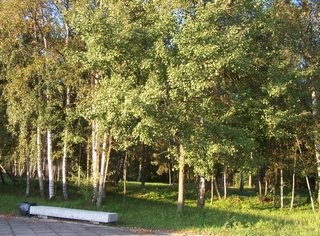The Holocaust deniers met this week, hosted by Iranian President Ahmadinejad. With all the detailed records kept by the Nazis during World War II, and all the documentation produced after the fact by the Allies, the only people who deny the Holocaust these days are the ones who want to finish the job.
Here is my post:

In Poland, we visited a concentration camp. It wasn’t one of the big names most people have heard of. Auschwitz is in the south of Poland, and we were in the north. Treblinka was father east than we were, so we went to Stutthof, which was the first Nazi concentration camp to be established outside of Germany and was the last one to be liberated by the Allies.
Stutthoff is surrounded by dense woods of tall, slender birch and oak trees that were just beginning to turn colors for autumn. If it weren’t for the marker stone at the start of the entrance road, we’d never have known it was there. I think that’s why the Nazis built so many death camps in Poland, because they were easily hidden by the woods. And because it was easier to kill Poles there. Through the trees in this picture are death camp buildings.
The total death count in the Holocaust of World War II was ten million. Six million of them were Jews. Millions more were Poles. The people of Poland are among the forgotten victims of the Holocaust.
From July of 1939 to May of 1945, Stutthof held 110,000 people, and 65,000 of them died, most of them from disease or starvation. In 1943, the exterminations began with the construction of the gas chamber, which used Zyklon gas (as did Auschwitz--Treblinka used diesel exhaust), and the ovens.
We watched an English-language film that showed the results of the investigation conducted by the Allies--most likely the Soviets. The hardest part was when they showed the enormous pile of shoes they found: 450,000 pairs of shoes. Men’s, women’s, and children’s shoes. In one of the buildings that’s still intact, they have part of this pile of shoes, and someone had laid a single red rose on top of it.
There were roses in other places too. Twined through barbed wire, or resting on the floor under the photo of one of the victims, or by the opening of one of the ovens. To me, the exhibits were simply names and faces of people I didn’t know, enlarged documents and photographs serving as examples of the many who had died there. But those names and faces had once been loved--and still were loved and mourned. The roses implored me to mourn too.
When I was in Poland in 1997, our group was there for nearly three weeks, and we traveled all over the country. We visited Auschwitz in a dreary rain, entering through the gates that declared, “Arbeit Macht Frei.” It’s a well-preserved museum to the cruelty that people are capable of--any of us, given the right conditions. It has glass cases of luggage, of kitchen ware, of eyeglasses, of human hair, and of crutches and braces and prostheses, all of these things taken from the victims and sorted for shipping by train to Germany. And you see, in those cases, something that hits home. That braid of hair looks like your sister’s. Those eyeglasses are just like your grandfather’s. That suitcase… The leg brace…
While Auschwitz shows the details of what the Nazis did, Treblinka, both a work camp and an extermination camp, is more of an artist’s rendering. After an escape by some of the prisoners in 1943, the Nazis destroyed the evidence of their presence and abandoned the place. Notes and maps smuggled out during its time of operation helped after the war to find the graves and the places where the killings were done. It’s been reconstructed in a stylized way.
Stutthof’s level of preservation falls somewhere between these two. Many of the buildings are still intact, but even more buildings are revealed only by the foundation or a marker stone. The beauty of the surrounding woods and green grass offers too much contrast to the stories that lie inside the buildings--stories of lives lived and destroyed there.
The sights at Stutthof were more than some of our group could bear. For the two of us who continued, there were some things we saw that would have been wrong to photograph. This monument sits at the far end of the camp from the entrance. Behind it to the right, the brick smokestack rests atop the crematorium close to the building where the people were gassed.
The back side of the monument's horizontal wall is built like an aquarium, with thick glass set in the structure. Behind the glass is ash and bone. The monument itself is made to look like the ash, compressed and built up, and the faces carved into the top of the pillar call out for people to remember.
And we do. Most of us.
3 comments:
This is very moving...thank you for sharing. It's hard to fully wrap my mind around it...but that sandal picture...wow.
Bekah,
Sixty years ago those sandals were whole shoes, but they've deteriorated over the years. It was hard watching the film, because they had footage of this mountain of shoes, and it was the little shoes that brought us to tears.
The picture that gets to me is the rose in the barbed wire. It was the Soviet Army that "liberated" Poland, only to start sending Polish people to the gulags. It's as though the barbed wire never came down until 1989.
I've been to three of the death camps now, and I don't know if I'll ever be able to fully wrap my mind around it.
I'm glad you stopped by. Come back any time.
thanks for the post. a much needed reminder.
Post a Comment